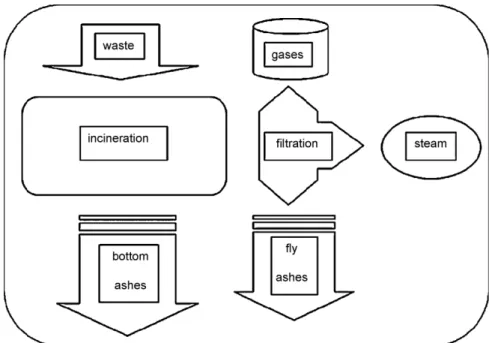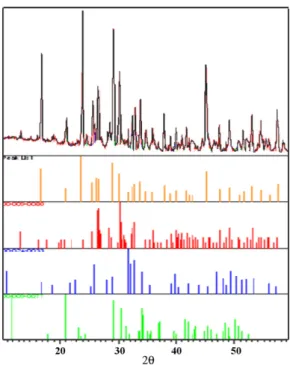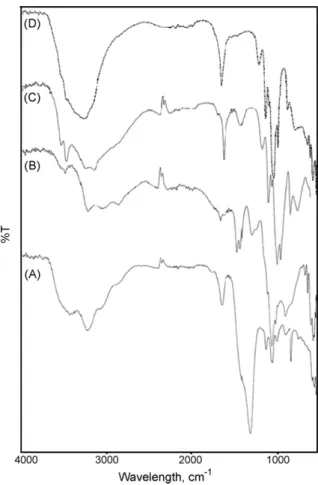HAL Id: hal-01634028
https://hal.archives-ouvertes.fr/hal-01634028
Submitted on 11 Feb 2019
HAL is a multi-disciplinary open access
archive for the deposit and dissemination of
sci-entific research documents, whether they are
pub-lished or not. The documents may come from
teaching and research institutions in France or
abroad, or from public or private research centers.
L’archive ouverte pluridisciplinaire HAL, est
destinée au dépôt et à la diffusion de documents
scientifiques de niveau recherche, publiés ou non,
émanant des établissements d’enseignement et de
recherche français ou étrangers, des laboratoires
publics ou privés.
Hazardous animal waste carcasses transformation into
slow release fertilizers
Patrick Sharrock, Marina Fiallo, Ange Nzihou, Mouna Chkir
To cite this version:
Patrick Sharrock, Marina Fiallo, Ange Nzihou, Mouna Chkir. Hazardous animal waste carcasses
transformation into slow release fertilizers. Journal of Hazardous Materials, Elsevier, 2009, 167 (1-3),
pp.119-123. �10.1016/j.jhazmat.2008.12.090�. �hal-01634028�
Hazardous animal waste carcasses transformation into slow release fertilizers
Patrick Sharrock
a,∗, Marina Fiallo
a, Ange Nzihou
b, Mouna Chkir
baLERISM, Paul Sabatier University, Castres 81104, France bRAPSODEE, Ecole des Mines d’Albi-Carmaux, Albi 81013, France
Keywords:
Animal by-products Slow release fertilizer Calcium phosphate ashes
a b s t r a c t
Because of the need to address disposal of materials infected with pathogens new regulations have come into effect for the transport and disposal of dead farm animals or carcasses. For precautionary reasons, disposal to landfill, composting, biogas generation or fertilizer use are banned recycling paths because of incomplete knowledge about contamination transmission paths. Thermal treatment is recognized as a safe elimination process. Animal wastes have a high calorific value (above 16 MJ/kg). However, combustion of the organics leaves mineral residues (near 30%). The ashes contain mostly calcium and phosphate with some sodium, potassium and magnesium. We have examined the transformation of the ashes into a slow release fertilizer. We used a mixture of acids to partly dissolve the combustion residues and form slurry. In a second step, base was added to neutralize and solidify the reaction mixture. The final product was a whitish polycrystalline solid. Leaching tests were made to evaluate the nutrient release rate in laboratory columns. Water leachates were analyzed for up to ten pore-bed volumes and showed, as expected, large differences in release rates. Nitrate release was slowed and phosphate did not level even after ten pore-bed volumes. This demonstrates that insoluble precipitates (gypsum) contribute to control soluble ion release.
1. Introduction
Dead animals and abattoir by-products represent nearly 30% of the live weight of processed animals. Animal by-products are classified in three different categories according to European reg-ulation (CE) 1774/2002 which entered into effect in 2003. Class 1 concerns products suspected of carrying infectious diseases, partic-ularly encephalitis, as well as contaminated by illicit or dangerous substances. Cadavers from wild, domesticated or zoo animals also enter this category. Class 2 pertains to farm animals found dead or containing medicinal residues. Class 3 is attributed to animal rem-nants originating from abattoir processing of human food grade certified live animals. This class can be valorized, usually by sepa-rating fats from lean components, and producing combustible lipids and meat and bone meal (MBM) for feed or fertilizer. Class 2 prod-ucts can also be valorized, but not in animal feed, whereas class 3 must be destroyed or co-incinerated[1,2].
In France, an average of 2.8 million tones of animal by-products is treated annually, including 1.8 million tones of class 3 materials. France represents 18% of the European production which totals over 15 million tones. Forty-nine percent goes directly into energy pro-duction, 21% into pet food, 17% serves in oil chemistry, 5% in animal
∗ Corresponding author at: Department of Chemistry, Avenue Pompidou, Castres 81104, France. Tel.: +33563621159; fax: +33562264783.
E-mail address:Patrick.sharrock@iut-tlse3.fr(P. Sharrock).
feed, 3% in human food, only 2% serves as fertilizer[3]and the rest in fuel such as biodiesel[4].
Products allowed in pet food include transformed animal pro-tein, gelatins, blood components, calcium phosphates, hydrolyzed feathers, grease and fish oils. The dangerous class 1& 2 products are incinerated (or co-incinerated with other wastes) as illustrated in Fig. 1. This process releases combustion gases to the atmosphere, allows recovery of steam, and leaves behind bottom ashes and fly ashes to be dealt with[5]. The increasing cost of land-filling thermal process residues is making incineration more expensive.
We have previously examined MBM ashes and reported on their properties[6,7]and potential beneficial reuse as phosphate miner-als[8]. In this report, we describe how the ashes from duck waste carcasses can be chemically transformed into a slow release fertil-izer (SRF).
The availability of plant nutrients in the soil is fundamental to improve growth and crop yields. The extent of P movement in soil is known to be dependent on moisture[9]. Phosphate fertilizer is also related to tillage[10]. Because phosphate is the usual limiting nutrient for the formation of algal blooms, phosphate losses by run-off and leaching should be minimized in agricultural land. SRF is an answer in this respect. Seasonal variations in soil N fertilizers have been correlated to water leaching[11], and application rates should not exceed crop removal rate to prevent nitrate pollution[12]. Mon-itoring soil solution N concentrations are recommended as well as using multiple applications of less soluble N sources (urea) to maintain optimum N concentrations at different times during the
Fig. 1. Flow diagram for the thermal destruction of animal by-products.
growing season. Again, a SRF would be a very practical solution to simplify fertilizer management[13]. The diffusion and reaction processes in soil of phosphate and calcium has been discussed[14]. It is now recognized that nutrient exports are related to excessive fertilizer loadings particularly in high rainfall zones[15].
Slow-release fertilizers are generally categorized into one of sev-eral groups: palletized or matrix based[16], chemically altered[17], coated[18]or infiltrated into zeolite reservoirs[19]. Because nutri-ents are released at a slower rate throughout the season with SRF, plants are able to take up most of the nutrients without waste by leaching[20]. SRF is also more convenient, since less frequent application is required[21].
2. Experimental
2.1. Animal wastes
Duck carcasses were placed in a ventilated muffle furnace and heated to 750◦C for 1 h using a 2◦/min. heating rate. After cooling to
room temperature, the ashes were crushed with a mortar and pestle and sieved to pass a 2 mm mesh. The yield of white to gray colored ashes was close to 30% of the starting weight. Samples were fur-ther ground to very fine powder for infrared spectroscopy (Mattson Genesis FTIR) and X-ray diffraction (Philips Xpert) analysis.
2.2. Formation of slow release fertilizer
Chemical transformation was operated in polyethylene vials by introducing 10 g of ashes into 10 ml of acid. The acids used were sulfuric acid, phosphoric acid or nitric acid at 10% by weight con-centration. The acid reaction produced foam and the frothing slowly subsided after 1 h. The still acid suspension was neutralized to pH 7 using the aqueous bases ammonium hydroxide or potassium hydroxide. Following this exothermal reaction, the suspension was mixed with a spatula to form a paste which solidified during the next 5 min. The SRF solids were broken into 5 mm granules to per-form the leaching tests.
2.3. Leaching tests
Leaching experiments were carried out in glass chromatography columns equipped with N◦3 sintered glass filters. Free flowing sand
was mixed with 10% by weight of the SRF granules and packed into the columns and covered with glass wool. After measuring the vol-ume of water need to saturate the solids in the column, leaching events were performed by introducing one bed volume of distilled water into the column and collecting the leachates exiting the col-umn by gravity at one atmosphere pressure. Calcinite (a mixed ammonium and calcium nitrate salt from Norsk Hydro) was used as a totally soluble fast release fertilizer to compare leaching rates under identical experimental conditions. Sulfate, nitrate and phos-phate anion concentrations were measured by ion chromatography (Metrohm) using a sodium hydroxide and carbonate buffer at pH 10. Small samples of the granules were extracted from the columns after the leaching events to analyze the remnants by FTIR (Matt-son Genesis). Thermogravimetric analysis was performed under air atmosphere with a SETARAM ATG92 instrument.
3. Results and discussion
3.1. Formation and reactivity of calcined bone
Duck carcasses begin to burn with emission of smoke at 300◦C.
At 500◦C the charred residues are dark black but after combustion
at 750◦C the ashes are off white. Industrial destruction of MBM
implies contact with flames at temperatures near 1000◦C. MBM has
exothermal combustion energy of 1.7 kJ/g. We preferred to expose the carcasses for 1 h at temperatures below 850◦C to prevent
car-bonate decomposition and sintering of the minerals. Thus the ashes reacted quickly with the acids, carbon dioxide gas escaped from the reaction mixture and the acids penetrated the porous calcined bone structures.
We previously showed the combustion residues are closely comparable to hydroxyapatite minerals[7]. Acid dissolution partly produces hydrogenphosphate anions and releases calcium ions. These ions recombine following neutralization to form a variety of sparingly soluble salts including monetite or brushite and gyp-sum. However, nitrate salts remain soluble but trapped into the composite matrix.
3.2. Analysis of slow release fertilizers
The X-ray diffraction analysis of the chemically transformed ashes is difficult due to the numerous products obtained when
sul-Fig. 2. X-ray diffraction patterns of SRF with sulfuric acid. From top down:
experi-mental pattern, line spectrum, anhydrite, gypsum, hydroxyapatite and bassanite.
furic and nitric acids are used simultaneously with potassium and ammonium hydroxides. We therefore analyzed the solids formed when only one acid was used to attack the carbonated hydroxya-patite. Figs. 2–4illustrate the powder patterns obtained for the three different acids, and the computer fitted component analy-sis. It can be observed that hydroxyapatite remains in all cases and that other insoluble calcium salts are formed. In the case of sul-furic acid, insoluble calcium sulfates are present in several forms (anhydrite, gypsum and bassanite) together with remaining apatite as can be seen inFig. 2. Nitric acid produces calcium nitrate and ammonium nitrate and in addition ammonium phosphate (Fig. 3). The presence of these products demonstrate that the acid effec-tively dissolves some of the apatite to release both calcium and
Fig. 3. X-ray diffraction patterns of SRF with nitric acid. From top down:
exper-imental pattern, line pattern, ammonium nitrate, calcium nitrate, hydroxyapatite and ammonium phosphate.
Fig. 4. X-ray diffraction pattern of SRF with phosphoric acid. From top down:
exper-imental spectrum, stick spectrum, monetite, hydroxyapatite, brushite.
phosphate ions which in this case remain in the form of soluble salts. With phosphoric acid, anhydrous and hydrated hydrogen-phosphates are formed (monetite and brushite) as shown inFig. 4. Globally, the acid attacks the ashes to partly transform the insolu-ble bone residues into different phosphates which would be more available as fertilizers.
Fig. 5represents the thermogravimetric analysis of the reaction product of the ashes with nitric acid followed by ammonia. Ammo-nium cations and water of crystallization can be quantified below 250◦C at 14% levels, nitrate decomposition at higher temperatures
accounting for the rest of the weight loss. Excess water is evaporated by the heat of the reaction during the neutralization step.
3.3. Leaching of slow release fertilizer components
The differential solubility of the components of SRF made with nitric acid and ammonia is demonstrated in Fig. 6. The strong and broad absorption band related to nitrate anion is present at 1350 cm−1in the starting product, but decreases rapidly in intensity
after leaching event 1. It is still present following leaching event 2 as
Fig. 6. FTIR spectra of SRF. Starting product (A), and following leaching event 1 (B),
2 (C) and 3 (D).
a small peak compared to the phosphate anion absorption centered at 1000 cm−1. No more nitrates are present after leaching event 3
as illustrated in spectrum D. In this spectrum, the main absorption band is at 3400 cm−1attributed to water stretching vibrations. The
phosphate group appears around 1000 cm−1 and the sharp peak
at 1600 cm−1 is an OH bending frequency. From the evolution of
spectra it can also be concluded that ammonium ions are leached progressively, as their stretching vibrations near 3000 cm−1 are
replaced by water vibrations.
The anion release kinetics is compared inFig. 7for a SRF made with all three acids simultaneously. Clearly nitrates are dissolved more rapidly with over 90% of the total amount released after the fourth leaching event. The total percentage of nitrates released is the sum of the amounts released at each successive washing, i.e. 20% + 36% + 28% + 10% = 94%. This total reaches 100% when the fifth
Fig. 7. Variations in anion release concentrations as a function of leaching event.
and sixth leaching events are taken into account (4% and 2% respec-tively), leaving no more available nitrates for subsequent leaching. On the other hand, less than half the sulphate or phosphate is dis-solved after 8 leaching events. The sum of the 8 sulphate fractions is 37%, while the sum of the phosphates represents 44% of the total phosphates present. These results show that the added acids have produced slowly soluble calcium salts and that the composite gran-ules act as continuous release reservoirs. Even the soluble nitrates are considerably slowed compared to Calcinite fast release fertilizer evaluated under the same experimental conditions.Fig. 7shows 90% dissolution after two leaching events, which is twice as fast as for the nitrates present in the SRF.
The mechanism of formation of the granules can be explained as follows: during the first step, the acids attack the bone struc-ture and dissolve a large part of the hydroxylapatite present by forming soluble calcium salts (calcium nitrate, calcium dihydro-genphosphate) and less soluble salts (gypsum and monetite) that partly coat the remaining bone minerals. The second step neutral-izes unreacted excess acid and forms more soluble salts such as ammonium or potassium phosphates. However all these products are compounded in a mass of hydrated crystals resembling plaster of Paris which solidifies during the exothermal neutralization. Fur-ther work would be needed to investigate the fate of the remaining solids following extended lixiviation and to increase the amount of valuable soluble phosphate release. It is expected that smaller particle sizes or longer reaction times would increase the yield of fertilizer.
4. Conclusion
Thermal destruction of animal carcasses yields calcium phos-phate mineral residues which can be reacted chemically with common acids to dissociate partially the carbonated apatite struc-tures. Neutralization of excess acids forms salts which tend to form hydrated solids and solidify. Experimental granules made with the ashes and chemical transformation produce a new type of fertilizer with slower and more prolonged release of nutrients. Such ashes should not be considered as waste but as a valuable resource to replace and substitute for natural phosphate rock.
Acknowledgements
The authors thank Dr.C. Tahon of Solvay, Brussels, for financial support of this work.
References
[1] O. Senneca, Characterisation of meat and bone mill for coal co-firing, Fuel 87 (2008) 3262–3270.
[2] L. Fryda, K. Panopoulos, P. Vourliotis, E. Karakas, E. Pavlidou, Meat and bone meal as secondary fuel in fluidized bed combustion, Proceed. Combust. Inst. 31 (2007) 2829–2839,doi:10.1016/j.proci.2006.07.151.
[3] C. Mondini, M.L. Cayuela, T. Sinico, M.A. Sanchez-Monedero, E. Bertelone, L. Bardi, Soil application of meat and bone meal. Short-term effects on mineral-ization dynamics and soil biochemical and microbiological properties, Soil Biol. Biochem. 40 (2008) 462–474.
[4] T. Geslain, L’industrie de la transformation des sous-produits animaux en 2006, French Industry Union Annual Meeting Report, 2007 (www.sifco.fr). [5] M. Cyr, C. Ludman, Low risk meat and bone meal (MBM) bottom ash in mortars
as sand replacement, Cement Concrete Res. 36 (2006) 469–480.
[6] E. Deydier, R. Guilet, P. Sharrock, Beneficial use of meat and bone meal com-bustion residue: “an efficient low cost material to remove lead from aqueous effluent, J. Hazard. Mater. 101 (2003) 55–94.
[7] E. Deydier, R. Guilet, S. Sarda, P. Sharrock, Physical and chemical characterisation of crude meat and bone meal combustion residue: “waste or raw material? J. Hazard. Mater. 121 (2005) 141–148.
[8] S. Baillez, A. Nzihou, D. Bernache-Assolant, E. Champion, P. Sharrock, Removal of aqueous lead ions by hydroxyapatites: equilibria and kinetic processes, J. Hazard. Mater. 139 (2007) 443–446.
[9] F.E. Khasawneh, E.C. Sample, I. Hashimoto, Reactions of ammonium ortho- and polyphosphate fertilizers in soil: I. mobility of phosphorus, Soil Sci. Soc. Am. J. 38 (1974) 446–451.
[10] T.M. Addiscott, D. Thomas, Tillage, mineralization and leaching: phosphate, Soil Tillage Res. 53 (2000) 255–273.
[11] M.K. Zang, L.P. Wang, Z.L. HE, Spatial and temporal variation of nitrogen exported by runoff from sandy agricultural soils, J. Environ. Sci. 19 (2007) 1086–1092.
[12] G.H. Neilsen, D. Neilsen, Comparing fertigation and broadcast-application of N, P and K fertilizers in orchards, Tree Fruit Grape News (1999), July issue (www.agf.gov.bc.ca/treefrt/newslett/npk1.htm).
[13] A.R. Bangar, B.C. Chaudari, Nutrient mobility in soil, uptake, quality and yield of Suru sugarcane as influenced by drip-fertigation in medium vertisols, J. Indian Soc. Soil Sci. 52 (2) (2004) 164–171.
[14] E. Lombi, M.J. McLaughlin, C. Johnston, R.D. Armstrong, R.E. Holloway, Mobility and lability of phosphorus from granular and fluid monoammonium phosphate differs in a calcareous soil, Soil Sci. Soc. Am. J. 68 (2004) 682–689.
[15] N.J. Mathers, D.M. Nash, P. Gangaiya, Nitrogen and phosphorus exports from high rainfall zone cropping in Australia: issues and opportunities for research, J. Environ. Qual. 36 (2007) 1551–1562.
[16] J.A. Entry, R.E. Sojka, Matrix based fertilizers reduce nitrogen and phosphorous leaching in three soils, J. Environ. Manag. 87 (2008) 364–372.
[17] K.C. Killian, O.J. Attoe, L.E. Engelbert, Urea formaldehyde as a slowly available form of nitrogen for Kentucky bluegrass, Agron. J. 58 (1996) 204–206.
[18] Y. Dong, Z.Y. Wang, Release characteristics of different N forms in an uncoated slow/controlled release compound fertilizer, Agricult. Sci. China 6 (2007) 330–337.
[19] T.K. Broschat, Nitrate, phosphate, and potassium leaching from container-grown plants fertilized by several methods, Hort. Sci. 30 (1) (1995) 74–77.
[20] T. Emilsson, J. Berndtsson, J.E. Mattsson, K. Rolf, Effect of using conventional and controlled release fertiliser on nutrient runoff from various vegetated roof systems, Ecol. Eng. 29 (2007) 260–271.
[21] D.A. Cox, Reducing nitrogen leaching losses from containerized plants: The effectiveness of controlled release fertilizers, J. Plant. Nutr. 16 (1993) 533–545.


